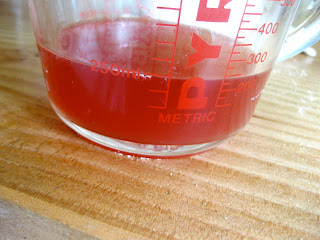This is the time of the year for harvesting prickly pears known in Spanish as tuna. They grow on the prickly pear cactus and have many uses: jam, juice, vinegar, wine, syrup and the cochineal insect that eats the fruit has been used to make dye. The pads of the cactus are also edible and are called nopales. The cactus is quite prolific in Albuquerque and comes in many varieties. Some have large fruit, about 4 inches long and others, like the ones above, are just a couple of inches long.
Our neighbor has quite a large, sprawling plant and he wasn't planning on harvesting the fruit this year so he let me have at it. I harvested enough to make 10 cups of juice! The process for harvesting and processing prickly pears is time consuming but, in my opinion, worth it. I've found myself scouting out other plants in the area to inquire about harvesting. We'd have juice and jam to last through the year!
The first step in prickly pear harvesting is to pluck the fruit from the spiny cactus. Even though the spines on the cactus pads look vicious, the small ones on the fruit are even more sinister. Called glochids, these miniscule spines can be very painful and hard to remove. So, harvesting the pears involves using long tongs and I would recommend wearing leather gloves, too.
Once harvested, it's time to process them. The first step is to remove those nasty glochids. Some websites recommend wearing gloves and scrubbing them with a vegetable brush. I felt like that was a little too close to the glochids, so I went for the burn-'em-off strategy. Holding the fruit in metal tongs I ran each one through the flame of my gas stove. This is what took the longest, since the fruit were so small. You can see some of the glochid casualties on the stovetop.
 |
| Nasty little buggers |
Once the glochids have been removed, I put the whole fruit in a large, non-reactive pot, filled it with water to cover, and brought it to a rolling boil. (If the fruit were bigger, I would have halved or quartered them. ) It boiled for a good 10 minutes and then I removed it from the heat. With a potato masher I crushed the fruit until it seemed like there weren't any whole fruit remaining. Next I strained the juice by placing a fine mesh strainer over a large bowl. Into the strainer I put two layers of cheesecloth and ladled the mess into it. When it seemed like it was just about finished straining, I gathered up the corners of the cheesecloth (I recommend putting your gloves back on.) and gave the bundle a few good squeezes with a clean pair of tongs to get out the last remaining juice. Prickly pear juice is thick and kind of gooey. It reminded me a bit of okra slime, but the color is all together different.
From this point you can do just about anything with the juice. I used 4 cups and this recipe from Homegrown Evolution to make 6 half-pints of jelly. I chose not to hot-water process them and just put them in the fridge. Some of the jars didn't set up quite right, but we had delicious pancakes with prickly pear "syrup" for breakfast the next morning!
For the rest of the juice I added some sugar and poured it into ice cube trays so we can have juicy drinks anytime. I'm not sure if it's the gooey nature of the juice or the added sugar that made the cubes sticky and a touch tricky to remove from the trays. I'm working on some recipes using the juice. It definitely needs to be diluted, sweetened and mixed with something. So far lemon and lime juices have worked out well. I think a carbonated lemonade would be divine. I'm also toying with the idea of adding it to home-brewed kombucha. (I just started my first batch today! Watch for future posts on that.)
After the processing I was really careful with the clean up. I could see glochids everywhere and wanted to limit our interaction with these small brutes of nature. Even though I wore gloves, used disposable rags and cleaned quite thoroughly I ended up with more glochids piercing my hands days after the project. This won't deter me, however. I will certainly do it all again and, hopefully, in the near future.




No comments:
Post a Comment